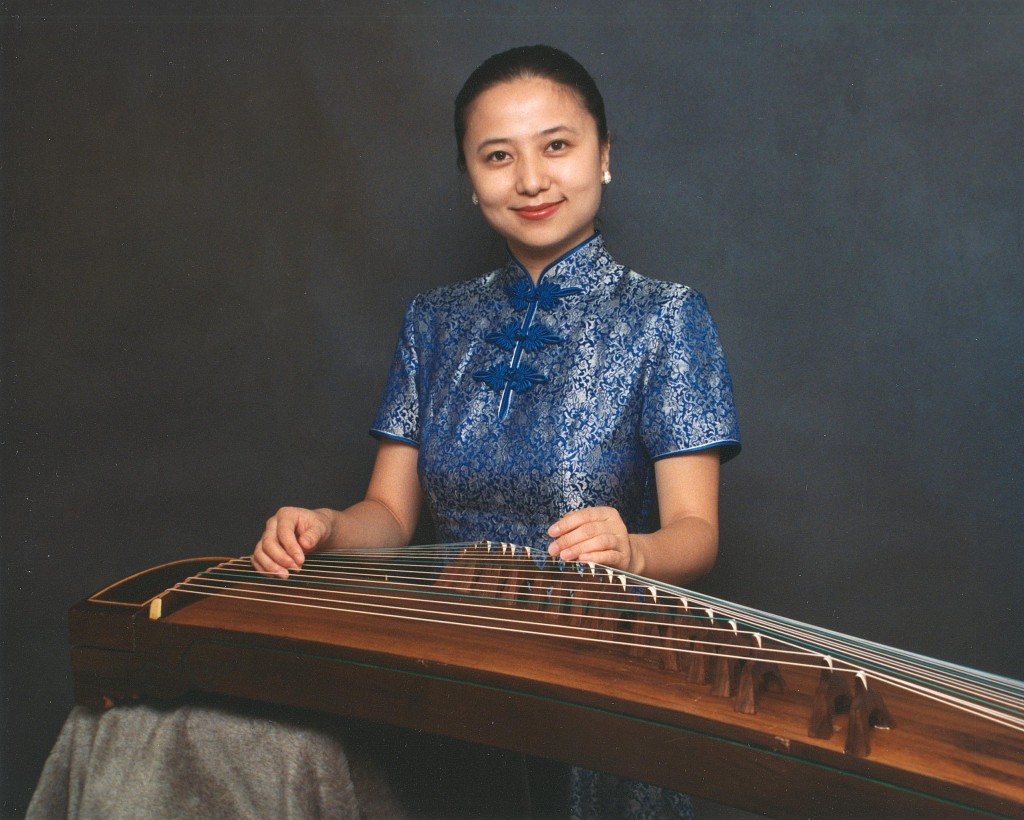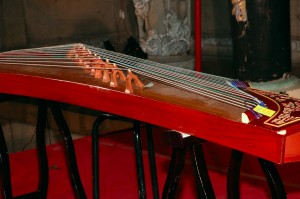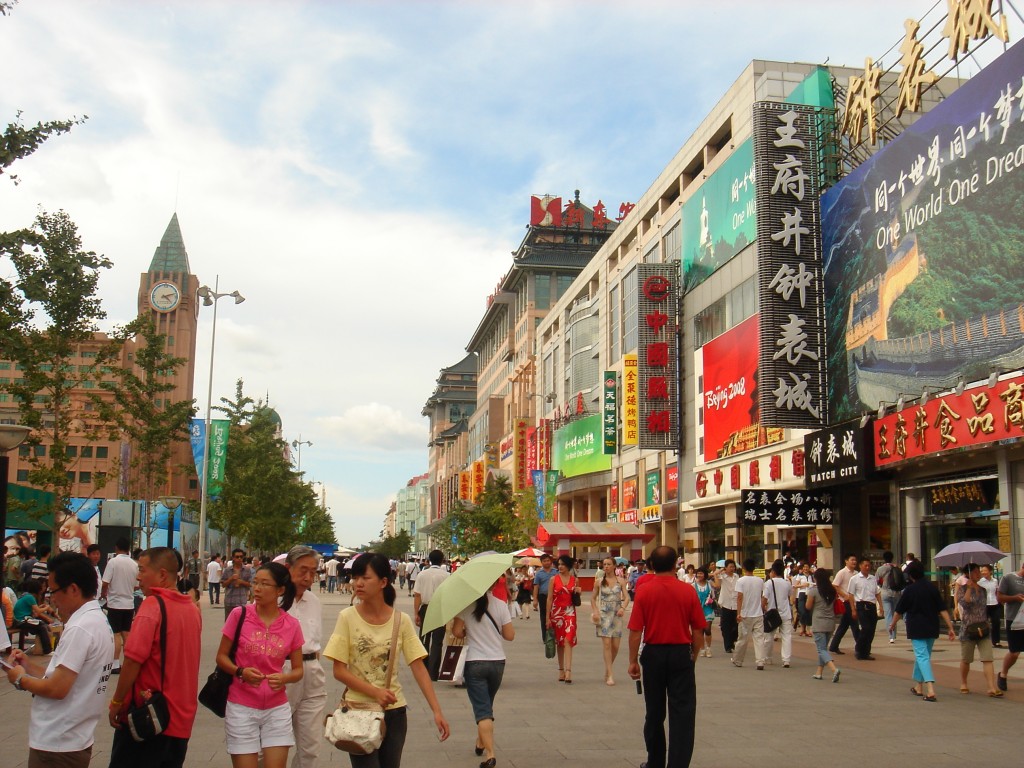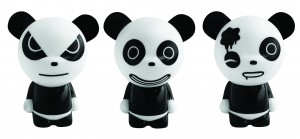
Haiqiong Deng, zheng (but not Dungeons & Dragons) virtuoso.
While my brain has been on sizzle in other realms of the arts world, apparently a blog has been going on in my own house. The entire world can check in on what my current first husband has been up to, but I’m afraid to say I’ve been rather ignorant about it.
I feel a little sheepish about writing, actually. Recently, Mr. Scatter wisely and broadly covered America’s current fascination with Chinese culture, Martha Ullman West (otherwise known as Art Scatter’s highest paid correspondent) boldly encompassed the week’s vast dance scene and … me? Well, let me tell you about Cheez-Its.
***
A week ago Monday, Haiqiong Deng took a break from her concert tour to fly in from Boston and perform in Third Angle‘s China Music Now concerts.
 Haiqiong (hiCHONG) is a virtuoso on the zheng (chung), an ancient Chinese instrument similar to a zither. Hers has 21 strings, each with a bridge that can be moved. For weeks it had been the big mystery instrument to me. I knew it was big, but I didn’t know how big. I couldn’t wait to hear what it sounded like.
Haiqiong (hiCHONG) is a virtuoso on the zheng (chung), an ancient Chinese instrument similar to a zither. Hers has 21 strings, each with a bridge that can be moved. For weeks it had been the big mystery instrument to me. I knew it was big, but I didn’t know how big. I couldn’t wait to hear what it sounded like.
When the Third Angle staff (I’m the managing director) were figuring who could pick her up from the airport, we had two questions to consider: Who wasn’t playing in the symphony that night, and who has a vehicle long enough to fit a zheng in it.
Guess what? I won.
 I was thrilled. And then panic set in. Did I have enough time to clean up the Cheez-Its?
I was thrilled. And then panic set in. Did I have enough time to clean up the Cheez-Its?
Once a week, Mr. Scatter picks up six Large Smelly Sixth-Graders and schleps them to Dungeons and Dragons. You’ve heard of Soccer Moms? He’s a D&D Dad.
The boys pile in and then immediately grab for snacks and juice boxes. They’re usually pretty good about stuffing the trash into the garbage sack, but it’s six boisterous boys and crumbs fly.
A few hours before I was to meet Haiqiong at the airport, I realized I wouldn’t have time to get the van cleaned, but I had a few minutes to give it a once-over and open up the cargo hold. It was dusk and getting hard to see, but as soon as I plunked the back seat down one brilliant-orange square Cheez-It practically glowed.
I picked it up, noticed the van’s bulging trash sack and then threw it all in a garbage can. I took note that I didn’t have a replacement bag, but I told myself I’d worry about it later.
***
The baggage claim area at Portland International Airport has a sign: “Many bags look alike, please check tags.”
Haiqiong and I were chatty nonstop. People were everywhere, lots of luggage was going around the conveyer belt and we were chatty chatty chatty. She stopped at one point and grabbed a big suitcase off the belt and then we went on chatting. I occasionally eyed the conveyer belt for what I knew must be a hard-to-miss large something. I was curious. This was an important piece of Third Angle’s program. We flew her in specially to play it. What did it look like?
The crowd got thinner and thinner. The luggage disappeared bit by bit. And we continued to chat.
 And then after a while, I got this eerie feeling. I looked around. Nobody was there and not a single piece of luggage was going around the belt. Where was it?
And then after a while, I got this eerie feeling. I looked around. Nobody was there and not a single piece of luggage was going around the belt. Where was it?
As I tried to quell this horribly unsettled feeling, I looked everywhere and then looked some more. I finally noticed a corral of luggage in a restricted area in a far corner. I got closer. No weird overlarge bag. I got closer. Nothing but rising panic. I got closer. And finally … it came into view: Behind a mound of luggage one really long green bag sat by itself. Relief washed over me.
When I told a uniformed worker the green bag was ours, she pointed to a green suitcase and said, “You mean that one?”
“No,” I said, pointing, “THAT one.” She took one look at the bag — about one foot by two feet by six feet plus — and waved me around the barrier to get it myself.
The zheng was surprisingly light.
***
On Thursday morning I fired up the van, started to pull out of the driveway and then hit the brakes. I pulled back into the driveway, walked into the house and stood in front of Mr. Scatter. He looked up.
 “You need the van. It’s D&D day. And by the way, it doesn’t have any gas. Sorry. Gotta go.”
“You need the van. It’s D&D day. And by the way, it doesn’t have any gas. Sorry. Gotta go.”
But early in the afternoon in the office it hit me. The van had a bunch of boxes in it that I needed, including one very important sign for the concert that night. Mr. Scatter probably wouldn’t be back from D&D in time for me to get it. And I had left the back seat folded down so that there weren’t enough seats for the Large Smelly D&D Boys.
I made a phone call. How to get the boxes? Mr. Scatter had just filled the van with gas, he had put the back seat up and would drop by the office. Gawd, I love this man.
***
 “Can you schlep the zheng?” the Not-So-Mysterious Jane said after the concert late Friday night. “It needs to get back to the hotel.”
“Can you schlep the zheng?” the Not-So-Mysterious Jane said after the concert late Friday night. “It needs to get back to the hotel.”
“Schlep the zheng? Sure.”
I walked to get the van, my heels clicking on the sidewalk. When I opened it and looked around I suddenly remembered I had never replaced the garbage sack and the whole D&D gang had been in the van the day before. The back seat was littered with empty Cheez-It bags and juice cartons. I quickly stuffed it all in the snack bag and stashed it under a console.
It would have to do. It was time to schlep the zheng and one world-class virtuoso.
— Laura Grimes

 The Portland Art Museum, in a show assembled by London’s Victoria and Albert Museum, heralds the arrival of China Design Now. (“Now” is really then, but a recent then: The show was aimed to coincide with last year’s Beijing Olympics and to capture the wave of commercial and aesthetic design in the world’s most populous country, a wave that inevitably has since washed on.)
The Portland Art Museum, in a show assembled by London’s Victoria and Albert Museum, heralds the arrival of China Design Now. (“Now” is really then, but a recent then: The show was aimed to coincide with last year’s Beijing Olympics and to capture the wave of commercial and aesthetic design in the world’s most populous country, a wave that inevitably has since washed on.) I remember that film well — the extreme, almost ecstatic enthusiasm of China’s musicians; Stern’s encouragement and good will; his sense that the older students and musicians he encountered — the ones who’d spent years being “reeducated” in peasant labor and cut off from contact with Western music — seemed technically correct but lacking passion in their playing.
I remember that film well — the extreme, almost ecstatic enthusiasm of China’s musicians; Stern’s encouragement and good will; his sense that the older students and musicians he encountered — the ones who’d spent years being “reeducated” in peasant labor and cut off from contact with Western music — seemed technically correct but lacking passion in their playing.